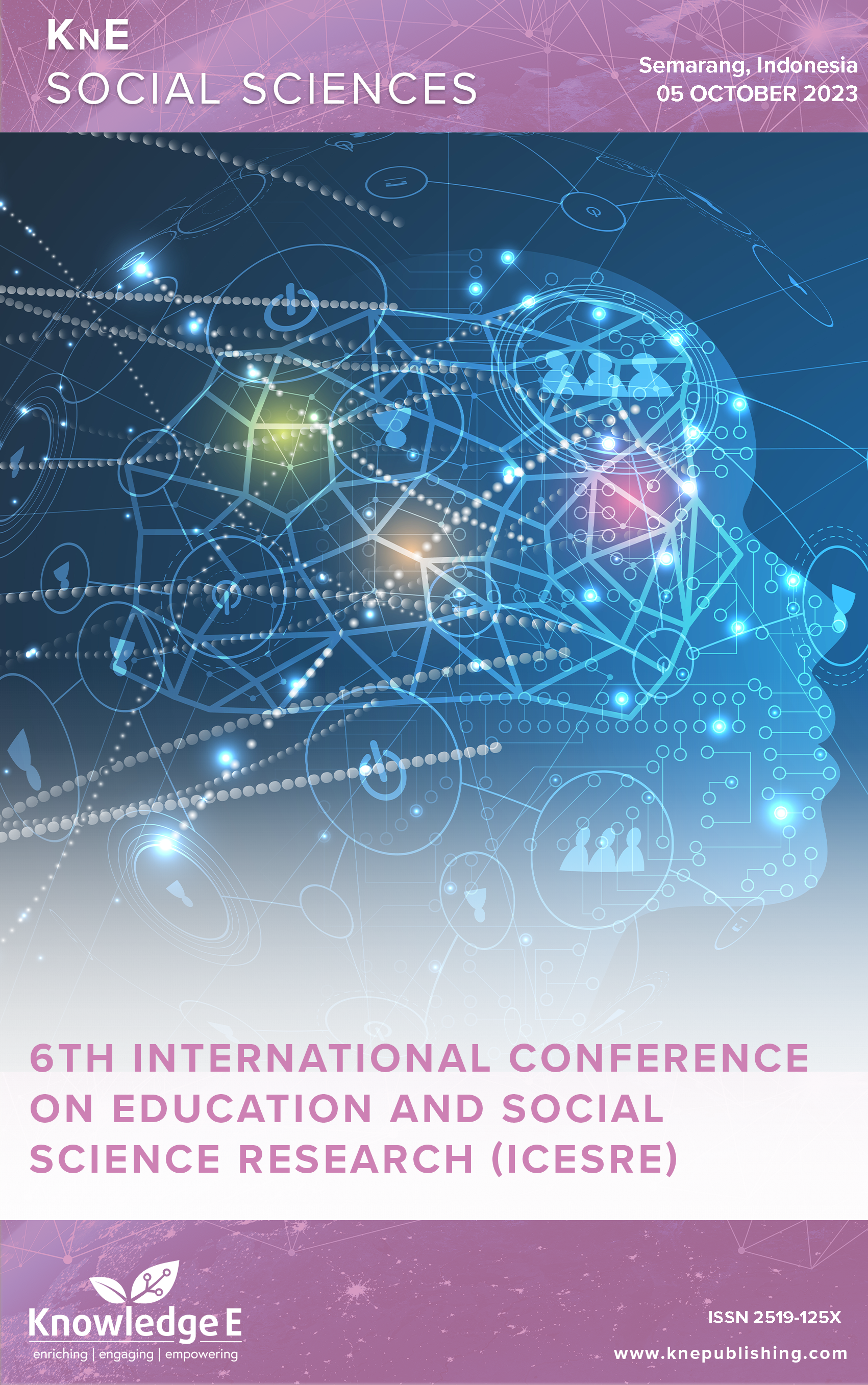Cultural Education of Children of Indonesian Workers in Sabah, Malaysia
DOI:
https://doi.org/10.18502/kss.v9i6.15315Abstract
Education and culture are related to each other and support each other in creating cultural identity in students. This research aims to analyze the cultural education of children of Indonesian workers in Sabah, Malaysia. The research method uses qualitative case studies. Five teachers, 25 students, two school principals, 25 parents, and one employee of the Consulate General of the Republic of Indonesia in Kinabalu were interviewed in depth to obtain valid data. Apart from that data collection was carried out by observing the cultural education of the workers’ children and conducting document studies. Data analysis was done using the Stake stage. The research results show that education is an effective way to transfer cultural values to students because, in education, the transfer of cultural values is carried out in a systematic, structured, and measurable way. Cultural education for the children of Indonesian workers in Sabah, Malaysia is carried out in families, schools, and the community. Families, schools, and communities must work together to transfer Indonesian cultural values. Cultural education can help create Indonesian culture in the people even though they were not born, did not grow and develop, did not live, and do not remain in Indonesia. Cultural education shapes the behavior of students who can socialize in their community and adapt to their environment to attain their survival.
Keywords: education, culture, children of Indonesian workers
References
Normina. Pendidikan dalam Kebudayaan. Ittihad Jurnal Kopertais Wilayah XI Kalimantan. 2017; 15(28):17-28. https://doi.org/10.18592/ittihad.v15i28.1930
Zhang J. Educational diversity, and ethnic cultural heritage in the process of globalization. International Journal of Anthropology and Ethnology. 2019; 3(7): 1-10. https://doi.org/10.1186/s41257-019-0022-x DOI: https://doi.org/10.1186/s41257-019-0022-x
Hoguane I, Pinto AO. Education as a way of promoting human dignity. International Journal of Education, Culture and Society. 2023; 8(3): 149-155. https://doi.org/10.11648/j.ijecs.20230803.19 DOI: https://doi.org/10.11648/j.ijecs.20230803.19
Li J, Xue E. Investigating international students’ cultivation system for higher education sustainability in China: Stakeholder perspectives. 2022; 14(22): 1-11.https://doi.org/10.3390/su142215335 DOI: https://doi.org/10.3390/su142215335
Linton R. The cultural background of personality. New York, London: Appleton Century; 1945.
Newman J. Education as civilization. The Journal of Educational Thought. 1977; 11(3): 203-212. http://www.jstor.org/stable/23768660 DOI: https://doi.org/10.55016/ojs/jet.v11i3.43748
Froumin ID. Education practices and maturation. 2018; 60(2): 182-186. https://doi.org/10.1080/10609393.2018.1451192 DOI: https://doi.org/10.1080/10609393.2018.1451192
Brannen J. Cultures of Intergenerational transmission in four-generation families. The Sociological Review. 2006; 54(1): 133-154. https://doi.org/10.1111/j.1467- 954X.2006.00605.x DOI: https://doi.org/10.1111/j.1467-954X.2006.00605.x
Koentjaraningrat. Manusia dan kebudayaan Indonesia. Jakarta: Djambatan. 1988
Soemardjan S, Soemardi S. Setangkai bunga Sosiologi. Jakarta: Yayasan Badan Penerbit Fakuyltas Ekonomi Universitas Indonesia. 1974.
Linton, R. Antropologi: suatu penyelidikan temtang manusia. Bandung: Jemars. 1984.
Dewantara KH. Kebudayaan (bagian kedua). Yogyakarta: Majlis Luhur Taman Siswa. 2004.
Wissler C. Man and culture. London: George G. Harrap; 1923.
Kluckhohn C. The concept of culture, the science of man in the world crisis. New York: Columbia University Press. 1953.
Davis A. Managing corporate culture. Cambridge, MA: Blinger. 1984.
Hoebel E. Adamson, Weaver T. Anthropology and the human experience. New York: Mac Graw-Hill Inc. 1979.
Sholina CA. Pemenuhan hak-hak asasi anak tenaga kerja Indonesia di perkebunan sawit di wilayah Tawau, Sabah, Malaysia. Jurnal Pembangunan Manusia. 2022; 3(1): 1-21. https://doi.org/10.7454/jpm.v3i1.1029. DOI: https://doi.org/10.7454/jpm.v3i1.1029
Juanda. Peranan pendidikan formal dalam proses pembudayaan. Lentera Pendidikan. 2010; 13(1): 1-15. https://doi.org/10.24252/lp.2010v13n1a1 DOI: https://doi.org/10.24252/lp.2010v13n1a1
Creswell JW. Research design pendekatan kualitatif, kuantitatif, dan mixed. Yogyakarta: Pustaka Pelajar. 2016.
Bryman A. Social Research Methods fifth edition. Oxford: Oxford University Press. 2016.
Nasiri N, Sharifi H, Bazrafshan A, Noori A, Karamouzian M, Sharifi A. Ocular manifestations of COVID-19: A systematic review and meta-analysis. Journal of Ophthalmic & Vision Research. 2021;16(1):103-112. https://doi.org/10.18502/jovr.v16i1.8256 DOI: https://doi.org/10.18502/jovr.v16i1.8256
Semenenko D, Nazarov Y. Exhibition environment for visitors with visual impairments. Questions of Expertise in Culture, Arts and Design [Internet]; 2019 Jun 6-7; Yekaterinburg, Russia. Dubai: KnE Social Sciences; 2020 [cited 2021 Jun 3]. 6 p. Available from: https://doi.org/10.18502/kss.v4i11.7558 DOI: https://doi.org/10.18502/kss.v4i11.7558
Creswell JW, Creswell JD. Research design: Qualitative, quantitative, and mixed methods approaches. 5th ed. Thousand Oaks, California: Sage Publications; 2018.
Enoch AJ. Pulse oximetry in low-income settings: A case study of Kenyan hospitals [Doctoral dissertation on the Internet]. Oxford: University of Oxford; 2018 [cited 2021 Jun 2]. Available from: https://ora.ox.ac.uk/objects/uuid:95c3aabf-fc58-4a73-aa6d- 33703c36b4fb
Achadi MW. Interaksi pendidikan dan kebudayaan. Dinamika: Jurnal Kajian Kritis Pendidikan Islam. 2016; 2(1): 1-8. DOI: https://doi.org/10.32764/dinamika.v2i1.122
Sitepu E dan Kia AD. Culture and Education. Jurnal Saint Paul’s Review. 2021; 1(2): 120-130. DOI: https://doi.org/10.56194/spr.v1i2.12
Firdaus FA. Humanistic approach in education according to Paulo Freire. At-Ta’dib. 2017; 12(2): 25-48. https://dx.doi.org/10.211111/at-tadib.v122i2.1264 DOI: https://doi.org/10.21111/at-tadib.v12i2.1264
Idris M. Konsep pendidikan humanis dalam pengembangan pendidikan Islam. MIQOT: Jurnal Ilmu-ilmu Keislaman. 2014; 38(2): 417-434. https://dx.doi.org/10.30821/miqot.v38i2.101 DOI: https://doi.org/10.30821/miqot.v38i2.101
Wahyuni D, Ani N, Rustini T, Arifin MH. Analisis nilai-nilai budaya pada pembelajaran IPS di kelas 2 SD. Harmony. 2022; 7(1): 32-39. https://doi.org/10/15294/harmony.v7i1 DOI: https://doi.org/10.15294/harmony.v7i1.55990
Fisch JH. Internalization and internationalization under competing real options. Journal of International Management. 2008; 14(2): 108-123. https://doi.org/10.1016/j.intman.2007.05.012 DOI: https://doi.org/10.1016/j.intman.2007.05.012
Xiaoyu P. Socialization as a two-way process. The Chinese Journal of International Politics. 2012; 5(4): 341-367. https://doi.org/10.1093/cjip/pos017 DOI: https://doi.org/10.1093/cjip/pos017
Dewi IN, Harisanti BM, Sumarjan S. Integration of local wisdom through enculturation -assimilation-acculturation (EAA): a solution to enhance problemsolving skills. Jurnal Pendidikan Biologi Indonesia. 2021; 7(3): 231-239. https://doi.org/10.22219/jpbi.v7i3.13385 DOI: https://doi.org/10.22219/jpbi.v7i3.13385
Berry JW. Acculturation: living successfully in two cultures. International Journal of Intercultural Relations. 2005; 29(6): 697-712. https://doi.org/10.1016/j.ijintrel.2005.07.013 DOI: https://doi.org/10.1016/j.ijintrel.2005.07.013
Lewis L. Assimilation as ‘false consciousness’ higher education immigrant student’s acculturation beliefs and experiences. International Journal of Intercultural Relations. 2021; 83: 30-42. https://doi.org/10.1016/j.ijintrel.2021.04.012 DOI: https://doi.org/10.1016/j.ijintrel.2021.04.012
Antonelli C. The diffusion of an organizational innovation: international data telecommunications and multinational industrial firms. International Journal of Industrial Organization. 1985; 3(1): 109-118. https://doi.org/10.1016/0167-7187(85)90017- 7 DOI: https://doi.org/10.1016/0167-7187(85)90017-7

